Special Report
How Many People in Your State Are Burdened With Medical Debt?
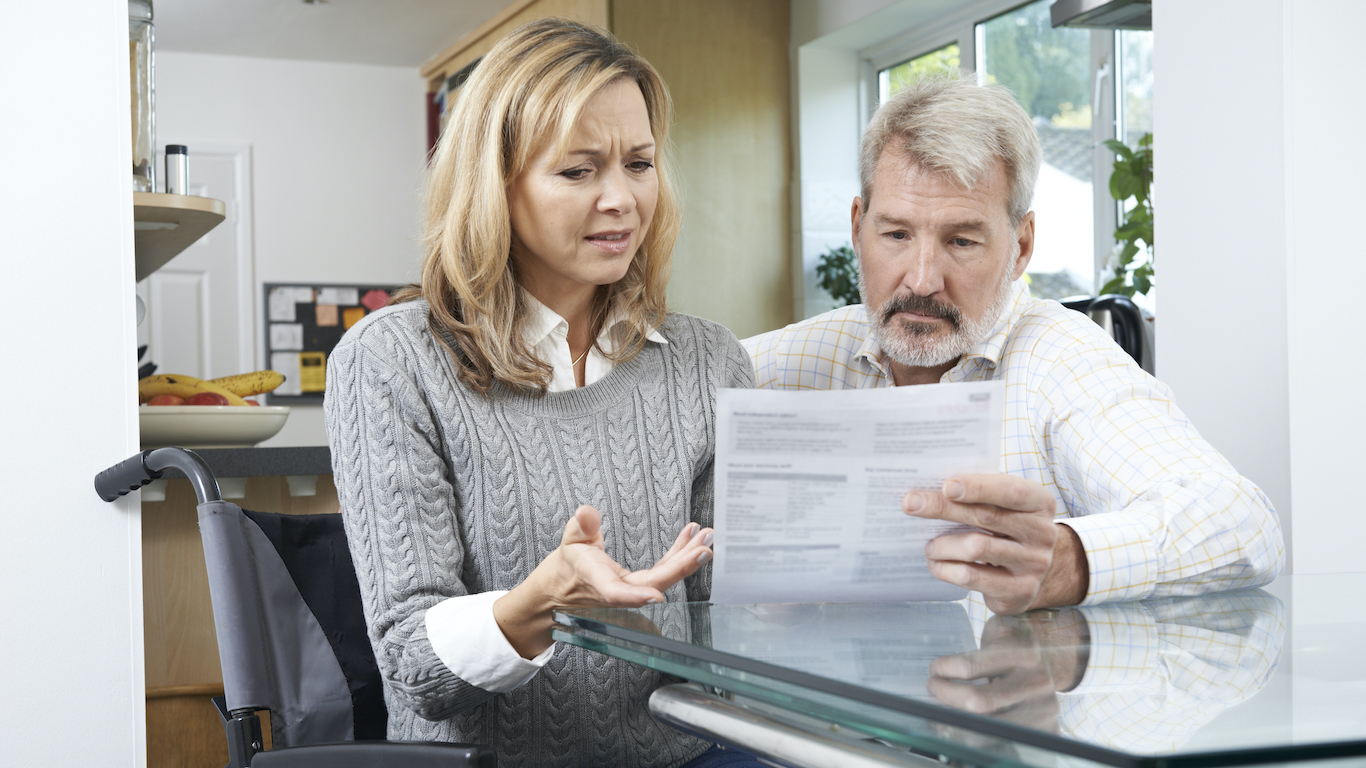
Published:
Last Updated:

The United States spends more per capita on health care than any other large developed country — and without a single-payer national health care system, much of that spending is shouldered directly by the consumer. And with over 80,000 confirmed cases of coronavirus to date — more than any other country in the world — the high cost of medical care is a pressing concern for a growing number of Americans.
According to a 2018 survey published by the Financial Industry Regulatory Authority, or FINRA, 22.7% of American adults have unpaid medical bills that are past due. Other surveys have shown that medical debt is the No. 1 reason Americans would consider liquidating their 401(k) or other retirement savings, and that about two-thirds of all personal bankruptcies are tied to health care bills.
24/7 Wall St. reviewed FINRA survey data to determine how many people are burdened with medical debt in each state. Depending on the state, the share of adults with overdue medical bills ranges from less than 15% to over 40%.
The states in which lower than average shares of residents are burdened with unpaid medical bills tend to have several factors in common. These states typically have lower uninsured rates, meaning a larger share of the population has medical coverage, which can make health care bills more manageable. Also, residents in these states have higher incomes, meaning more available resources to pay out-of-pocket costs. Here is a look at America’s richest and poorest states.
The consequences of being saddled with medical debt can be far-reaching. Americans living in states where a large share of the population is struggling to pay medical bills are often less likely to seek treatment for known medical problems because of financial concerns. The greater likelihood of residents forgoing necessary treatment may explain why in many of these states health outcomes, such as life expectancy, are worse than average. Here is a look at the least healthy city in every state.
Click here to see how many people in your state are burdened with medical debt
Click here to read our methodology

1. Alabama
> Adults with unpaid med. bills: 1.1 million (28.7% of adult pop. — 7th highest)
> Median medical debt in collections: $801 (12th highest)
> Uninsured rate: 10.0% (14th highest)
> Adults in fair or poor health: 21.4% (4th highest)
About 1.1 million adults living in Alabama — roughly 29% of the state’s 18 and older population — have some form of medical debt. Nationwide, 22.7% of American adults have unpaid medical bills. Perhaps even more telling, 24.7% of adult residents — the second-largest share of any state — report having skipped a medical test, treatment, or follow-up that was recommended by a doctor because of the cost.
As is often the case in states where large shares of the population are struggling to afford medical care, Alabama has a higher than average uninsured rate. Roughly 10.0% of the population does not have health insurance compared to 8.9% of the U.S. population.
[in-text-ad]

2. Alaska
> Adults with unpaid med. bills: 144,176 (26.1% of adult pop. — 15th highest)
> Median medical debt in collections: $1,316 (the highest)
> Uninsured rate: 12.6% (5th highest)
> Adults in fair or poor health: 13.4% (6th lowest)
In Alaska, 26.1% of adults have unpaid medical bills, a larger share than the 22.7% of Americans 18 and older with some form of medical debt. Not only is medical debt more common than average in Alaska, but it also tends to be higher. The typical amount of medical debt that has been handed over to collections agencies in Alaska is $1,316, nearly double the comparable national median of $694.
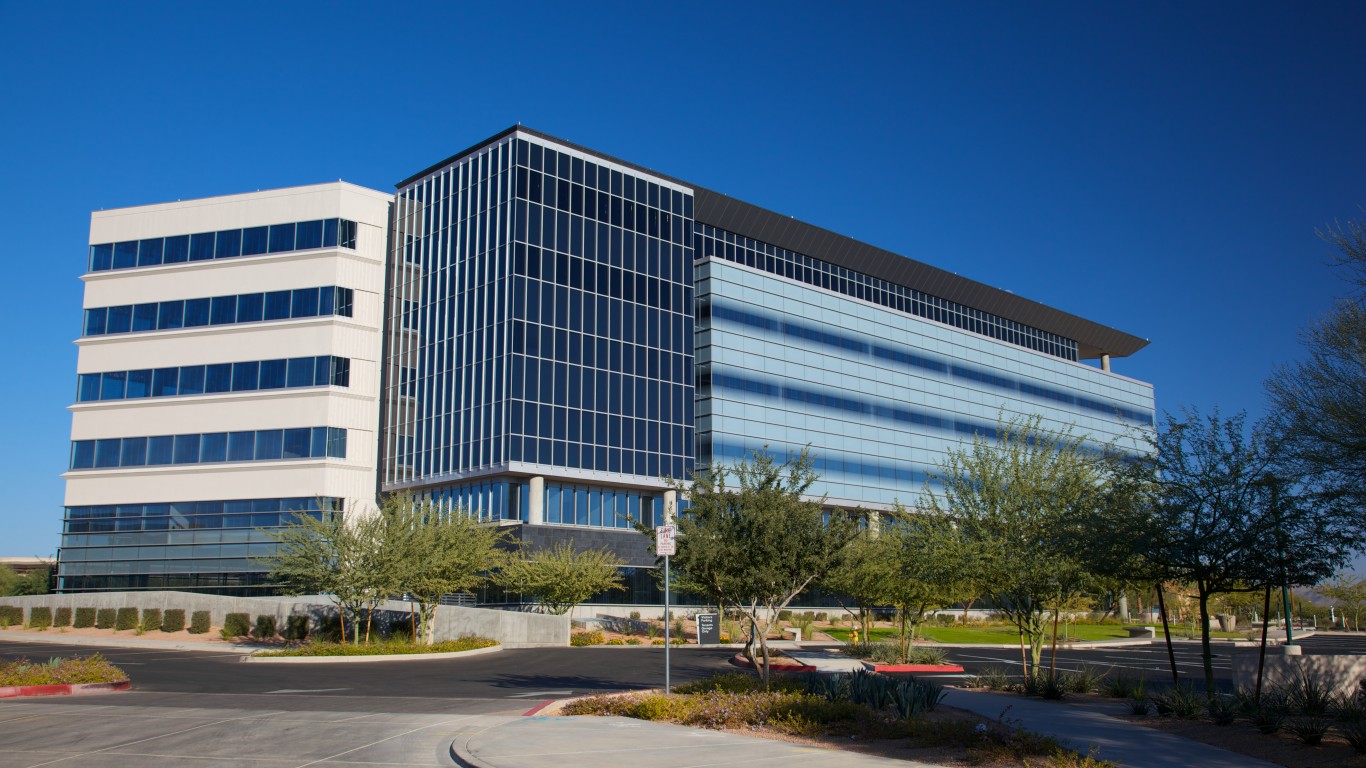
3. Arizona
> Adults with unpaid med. bills: 993,735 (18.0% of adult pop. — 11th lowest)
> Median medical debt in collections: $888 (6th highest)
> Uninsured rate: 10.6% (10th highest)
> Adults in fair or poor health: 17.8% (16th highest)
Nearly 1 million adults in Arizona — or 18% of the 18 and older population — have unpaid medical bills. For reference, 22.7% of adults nationwide have some form of debt related to medical treatment. While Arizona residents are less likely than Americans overall to have debt, those who have debt tend to have a lot of it. The median amount of medical debt that has gone to collections agencies in the state is $888, well above the comparable national median of $694.

4. Arkansas
> Adults with unpaid med. bills: 670,040 (29.0% of adult pop. — 6th highest)
> Median medical debt in collections: $596 (20th lowest)
> Uninsured rate: 8.2% (23rd highest)
> Adults in fair or poor health: 24.5% (the highest)
An estimated 29% of adults in Arkansas have some form of medical debt, a larger share than in all but five other states. The high cost of medical treatment is likely having a detrimental effect on the health of residents in the state as in the last year, 24.1% of adults said they had a medical problem but did not seek treatment due to cost.
[in-text-ad-2]

5. California
> Adults with unpaid med. bills: 4.4 million (14.3% of adult pop. — 2nd lowest)
> Median medical debt in collections: $740 (20th highest)
> Uninsured rate: 7.2% (21st lowest)
> Adults in fair or poor health: 17.5% (19th highest)
Americans with health insurance have to shoulder a far smaller share of their overall medical bills than those without insurance. In California, 7.2% of the population lacks health insurance, a smaller share than the national uninsured rate of 8.9%. Likely due in part to the greater than average coverage, just 14.3% of adults in the state have some form of medical debt, the second smallest share of any state.
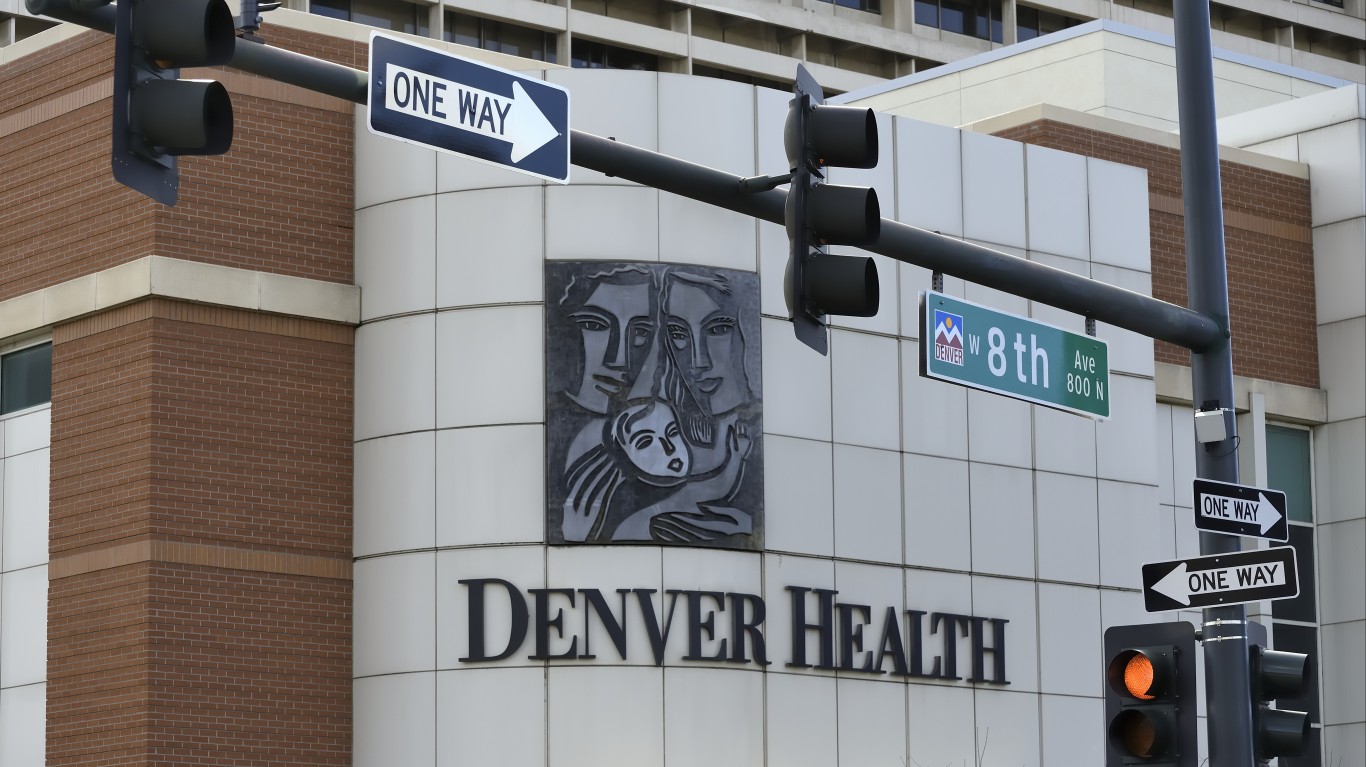
6. Colorado
> Adults with unpaid med. bills: 878,320 (19.8% of adult pop. — 14th lowest)
> Median medical debt in collections: $755 (19th highest)
> Uninsured rate: 7.5% (24th lowest)
> Adults in fair or poor health: 14.3% (16th lowest)
In Colorado, 19.8% of the 18 and over population has some form of outstanding medical debt, a smaller share than the 22.7% of American adults who do.
Colorado residents are also more likely to be healthy than Americans in much of the rest of the country. Adults in Colorado are more likely to exercise and less likely to smoke than most American adults, and Colorado’s 21% obesity rate is the lowest of any state in the country. These measures indicate a likely reduced risk of many serious — and potentially expensive — diseases and complications.
[in-text-ad]

7. Connecticut
> Adults with unpaid med. bills: 459,801 (16.2% of adult pop. — 5th lowest)
> Median medical debt in collections: $441 (4th lowest)
> Uninsured rate: 5.3% (7th lowest)
> Adults in fair or poor health: 13.8% (9th lowest)
Just 16.2% of Connecticut residents 18 and older have unpaid health care bills, the fifth smallest share of any state. The lower prevalence of medical debt is due in part to the low uninsured rate in the state. Just 5.3% of Connecticut residents lack health insurance, well below the comparable 8.9% share of Americans. High incomes in the state also mean more residents have the resources to pay their bills. The median annual household income in the state of $76,348 is about $14,400 higher than the national median income.

8. Delaware
> Adults with unpaid med. bills: 210,640 (27.6% of adult pop. — 9th highest)
> Median medical debt in collections: $601 (21st lowest)
> Uninsured rate: 5.7% (14th lowest)
> Adults in fair or poor health: 15.8% (25th lowest)
Just 5.7% of Delaware residents lack health insurance, well below the national uninsured rate of 8.9%. Even with insurance, health care can be a considerable financial burden, and in Delaware, 27.6% of the 18 and older residents have unpaid medical bills, the ninth largest share among states.
The state’s poorer health outcomes may be contributing to the higher share of adults with medical debt. By several behavioral measures and indicators, Delaware residents are at increased risk of serious, and potentially expensive to treat, diseases and conditions. Adults in Delaware are more likely to smoke and less likely to exercise than the typical American adult. Additionally, 30.6% of adults in the state are obese, a slightly higher rate than the national obesity rate of 29.0%.

9. Florida
> Adults with unpaid med. bills: 3.5 million (20.7% of adult pop. — 19th lowest)
> Median medical debt in collections: $921 (5th highest)
> Uninsured rate: 13.0% (4th highest)
> Adults in fair or poor health: 18.5% (13th highest)
The 20.7% share of adults in Florida with medical debt is slightly below the 22.7% comparable share of adults nationwide. Still, those with debt in the state are likely to have more of it. The median amount of medical debt handled by collections agencies is $921, far more than the national median of $694.
Both the amount of health care debt and the share of residents who have it would likely be reduced through increased government assistance for lower-income residents. Florida is one of a minority of states not to have adopted Medicaid expansion under the Affordable Care Act.
[in-text-ad-2]

10. Georgia
> Adults with unpaid med. bills: 2.4 million (29.9% of adult pop. — 4th highest)
> Median medical debt in collections: $808 (11th highest)
> Uninsured rate: 13.7% (3rd highest)
> Adults in fair or poor health: 18.8% (12th highest)
There are some 2.4 million adults in Georgia with unpaid medical bills, or nearly 30% of the state’s 18 and older population. Nationwide, 22.7% of adults have medical debt. The higher likelihood of debt in Georgia is due in part to the state’s large uninsured population. An estimated 13.7% of state residents are without health insurance compared to 8.9% of adult Americans nationwide. The high cost of treatment has also kept a staggering 27.0% of adults in the state from seeking treatment for a medical problem due to cost. Nationwide, 20.6% of adults have not sought treatment for a problem due to costs.
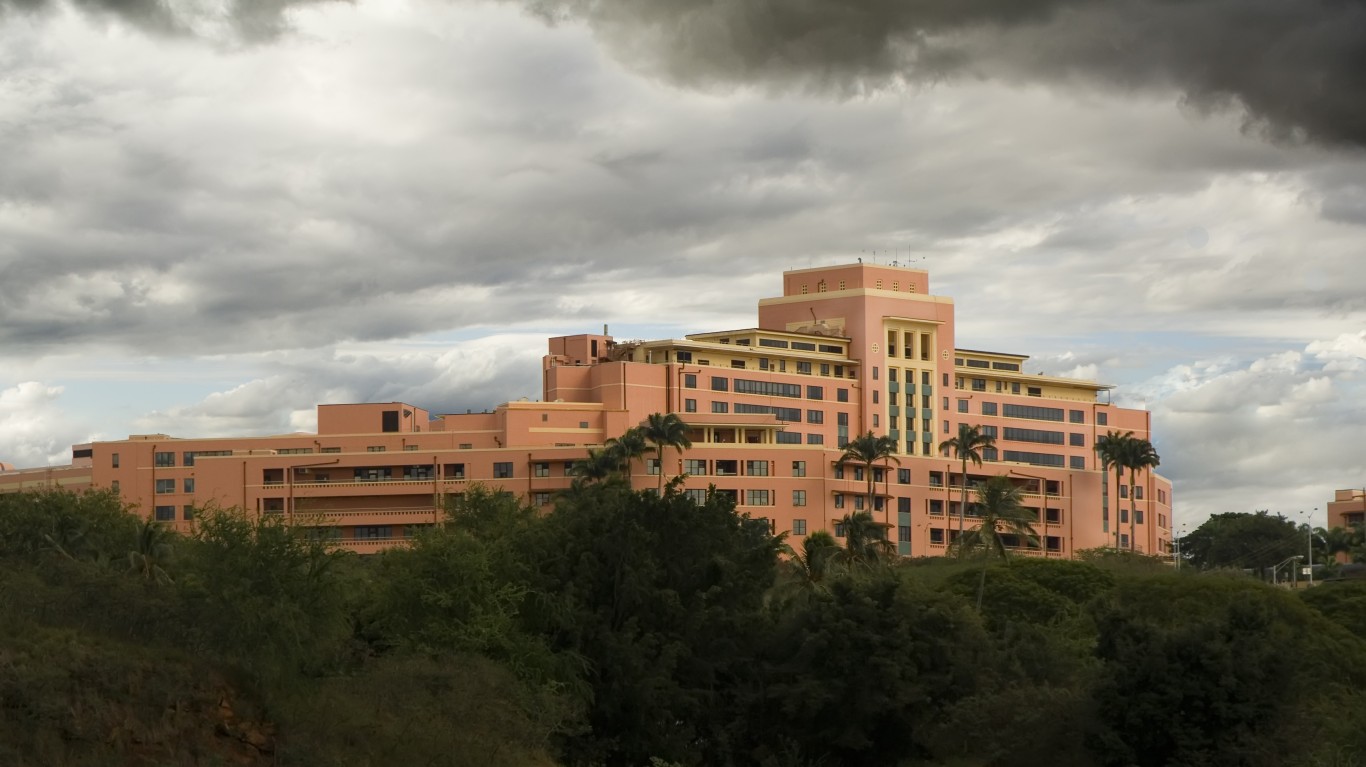
11. Hawaii
> Adults with unpaid med. bills: 150,289 (13.4% of adult pop. — the lowest)
> Median medical debt in collections: $232 (the lowest)
> Uninsured rate: 4.1% (4th lowest)
> Adults in fair or poor health: 14.0% (13th lowest)
Only 13.4% of adults in Hawaii have medical debt, the smallest share of any state in the country. The lower likelihood of medical debt in Hawaii is partially the product of low uninsured rates and high incomes. Just 4.1% of Hawaiians lack health insurance, less than half the 8.9% national uninsured rate. Additionally, the typical household in Hawaii earns $80,212 a year, about $18,300 more than what the typical American household earns. Hawaii also has the lowest median total turned over to collectors of any state, of just $232.
[in-text-ad]

12. Idaho
> Adults with unpaid med. bills: 313,132 (23.9% of adult pop. — 24th highest)
> Median medical debt in collections: $790 (13th highest)
> Uninsured rate: 11.1% (8th highest)
> Adults in fair or poor health: 15.3% (21st lowest)
In Idaho, 23.9% of 18 and older adults have unpaid medical bills, slightly larger than the 22.7% national share. Americans without health insurance typically pay far more out of pocket for medical treatment than those with insurance, and in Idaho, 11.1% of the population is without insurance, well above the 8.9% uninsured rate.

13. Illinois
> Adults with unpaid med. bills: 2.0 million (19.8% of adult pop. — 13th lowest)
> Median medical debt in collections: $555 (18th lowest)
> Uninsured rate: 7.0% (19th lowest)
> Adults in fair or poor health: 17.2% (21st highest)
A slightly lower than average share of adults in Illinois have unpaid medical bills at 19.8%. Those who do have outstanding medical debt are also more likely to have less of it than average. The median amount of medical debt that has been turned over to a collections agency in the state is just $555, well below the national average of $694.
The greater likelihood of Illinois residence being able to pay off their medical bills is likely partially due to higher incomes. The typical household in the state earns $65,030 a year, over $3,000 more than than the typical American household.

14. Indiana
> Adults with unpaid med. bills: 1.4 million (26.8% of adult pop. — 13th highest)
> Median medical debt in collections: $761 (18th highest)
> Uninsured rate: 8.3% (21st highest)
> Adults in fair or poor health: 17.7% (17th highest)
High medical costs appear to be taking a greater than average toll on the health of Indiana residents. More than one in every four adults in the state say they have opted not to receive care for a medical problem because of costs, compared to about one in every five adults nationwide. Indeed, Indiana residents are more likely to have medical debt than most Americans. An estimated 26.8% of state residents 18 and older have unpaid medical bills compared to 22.7% of adults nationwide.
[in-text-ad-2]

15. Iowa
> Adults with unpaid med. bills: 532,660 (22.0% of adult pop. — 22nd lowest)
> Median medical debt in collections: $535 (16th lowest)
> Uninsured rate: 4.7% (6th lowest)
> Adults in fair or poor health: 13.1% (5th lowest)
The 22.0% share of Iowans 18 and older with unpaid medical bills is closely in line with the comparable national figure. The amount of debt most Iowans are carrying is lower than average, however, as the median medical debt in the hands of collection agencies in the state is just $535 compared to an average of $694 nationwide.
Though Iowans are nearly twice as likely as the typical American to have health insurance, medical treatment can still have high out of pocket expenses, and a higher than average 22.7% share of adults in the state have not sought treatment for a medical problem due to costs.

16. Kansas
> Adults with unpaid med. bills: 601,589 (27.2% of adult pop. — 10th highest)
> Median medical debt in collections: $735 (21st highest)
> Uninsured rate: 8.8% (19th highest)
> Adults in fair or poor health: 15.0% (18th lowest)
A far higher than average 27.2% share of adults in Kentucky have unpaid medical bills. Although Kansas residents are about as likely as Americans overall to be covered with health insurance, the higher share of adults with medical debt is likely largely due to lower incomes in the state. The typical Kansas household earns $58,218 a year, nearly $4,000 less than the typical American household.
[in-text-ad]

17. Kentucky
> Adults with unpaid med. bills: 892,450 (25.8% of adult pop. — 18th highest)
> Median medical debt in collections: $459 (7th lowest)
> Uninsured rate: 5.6% (12th lowest)
> Adults in fair or poor health: 21.3% (5th highest)
An estimated 892,450 adults in Kentucky are saddled with unpaid medical bills, or about one in every four residents 18 and older. The fact that many residents appear unable to afford treatment is likely having a detrimental effect on public health in the state. In the last year, 23.1% of adults have had a medical problem yet not sought treatment due to the cost, compared to 20.6% of adults nationwide.

18. Louisiana
> Adults with unpaid med. bills: 1.0 million (28.4% of adult pop. — 8th highest)
> Median medical debt in collections: $697 (25th highest)
> Uninsured rate: 8.0% (25th highest)
> Adults in fair or poor health: 21.1% (6th highest)
An estimated 28.4% of adults in Louisiana have unpaid medical bills, a larger share than in the majority of states. While people in Louisiana are more likely to have insurance coverage than most Americans, health care can still be expensive, even for those with coverage. And for Americans with low incomes, this can often mean incurring debt. The typical household in Louisiana has an annual income of $47,905. Meanwhile, the typical American household has an income of $61,937.

19. Maine
> Adults with unpaid med. bills: 284,256 (26.0% of adult pop. — 16th highest)
> Median medical debt in collections: $729 (23rd highest)
> Uninsured rate: 8.0% (25th highest)
> Adults in fair or poor health: 15.4% (23rd lowest)
A greater than average share of adults in Maine have unpaid medical bills, at 26.0%. Though people in Maine are more likely than most Americans to have health insurance, health care can still have high out-of-pocket costs, even for those with insurance. Indeed, for many in the state, the inability to pay for a hospital visit, doctor appointment, or test, is likely due in part to limited financial resources. The typical Maine household earns $55,602 a year, well below the $61,937 median income nationwide.
[in-text-ad-2]

20. Maryland
> Adults with unpaid med. bills: 899,539 (19.1% of adult pop. — 12th lowest)
> Median medical debt in collections: $498 (12th lowest)
> Uninsured rate: 6.0% (15th lowest)
> Adults in fair or poor health: 13.9% (11th lowest)
Marylanders are more likely to be able to pay a bill from a doctor’s appointment or hospital visit than most Americans. Only 19.1% of adults in the state have unpaid medical bills compared to 22.7% of adults nationwide.
The lower likelihood of debt is likely attributable to higher incomes and lower uninsured rates. The typical Maryland household earns $83,242 a year, the most of any state in the country. Additionally, just 6.0% of state residents are uninsured, well below the 8.9% national uninsured rate.
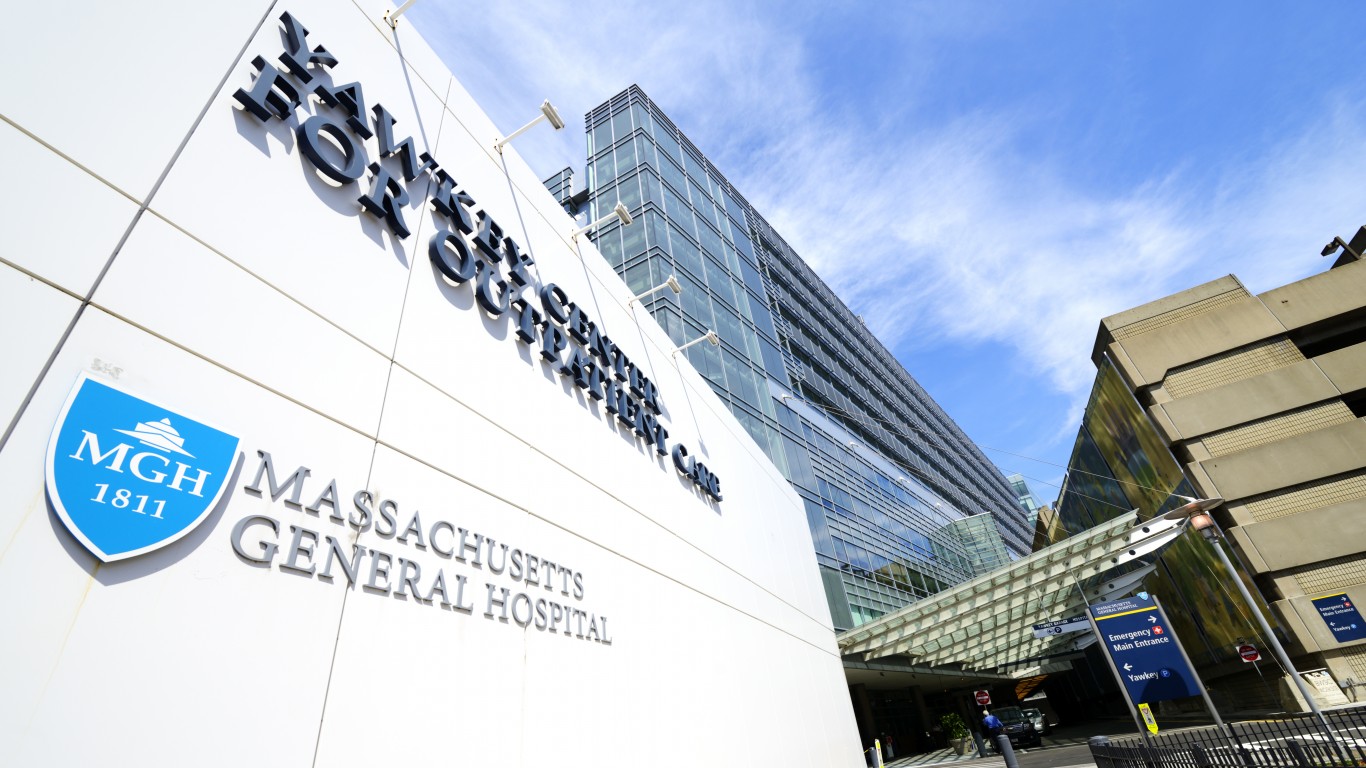
21. Massachusetts
> Adults with unpaid med. bills: 911,642 (16.5% of adult pop. — 6th lowest)
> Median medical debt in collections: $354 (2nd lowest)
> Uninsured rate: 2.8% (the lowest)
> Adults in fair or poor health: 13.8% (8th lowest)
Massachusetts residents are more likely than Americans in every other state to have health insurance coverage. Just 2.8% of people in the state lack insurance, well below the 8.9% national uninsured rate. Partially as a result, the share of adults in Massachusetts with unpaid medical bills, at 16.5%, is far lower than the 22.7% national average.
The state’s widespread insurance coverage is also likely improving public health in Massachusetts. Just 14.9% of adults in Massachusetts report not going to a doctor or clinic in the last year for a medical problem due to cost, a smaller share than the comparable 20.6% national figure.
[in-text-ad]

22. Michigan
> Adults with unpaid med. bills: 1.6 million (20.2% of adult pop. — 16th lowest)
> Median medical debt in collections: $497 (11th lowest)
> Uninsured rate: 5.4% (9th lowest)
> Adults in fair or poor health: 17.4% (20th highest)
An estimated 1.6 million adults in Michigan have outstanding medical debt, or one in every five residents 18 and older, which is a smaller share than in most states. This is likely because Michigan residents are more likely to have health insurance than the typical American. Just 5.4% of state residents are uninsured compared to 8.9% of Americans nationwide.
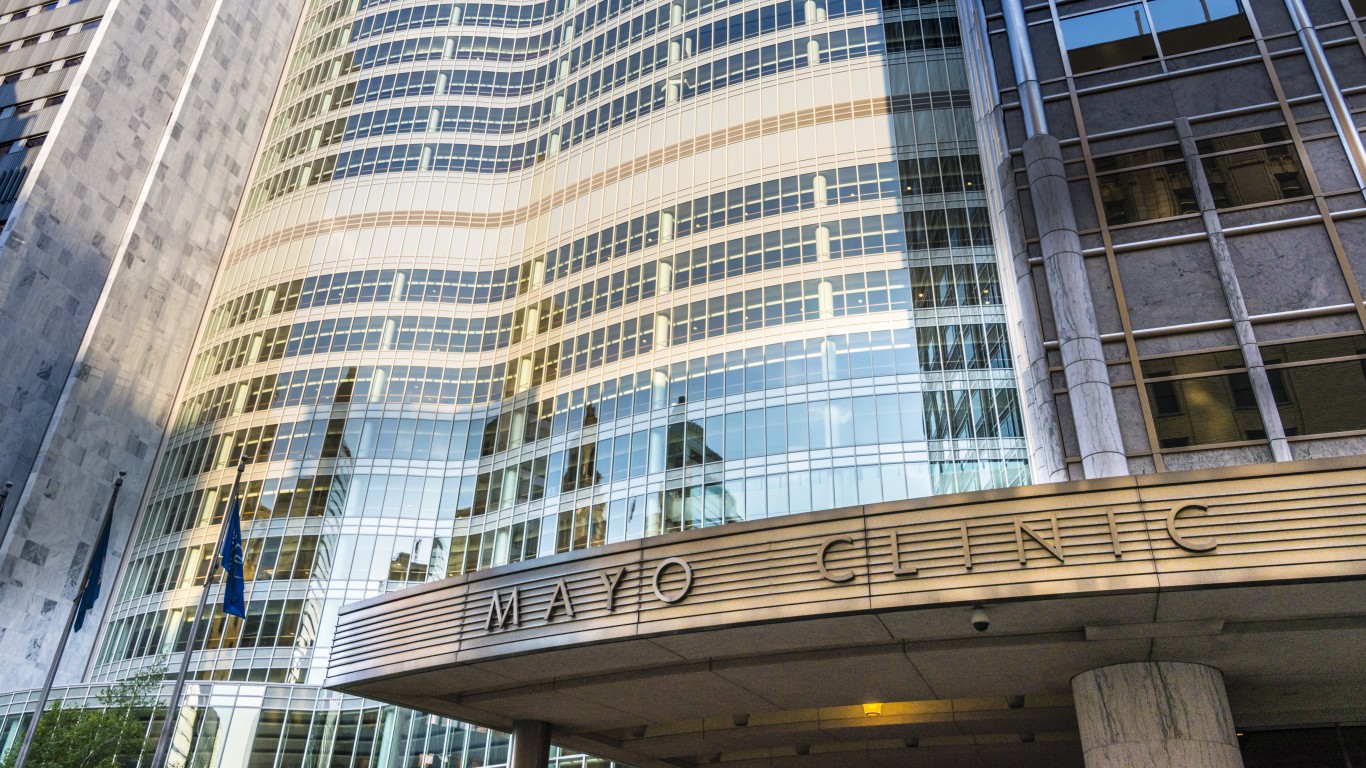
23. Minnesota
> Adults with unpaid med. bills: 745,744 (17.3% of adult pop. — 8th lowest)
> Median medical debt in collections: $360 (3rd lowest)
> Uninsured rate: 4.4% (5th lowest)
> Adults in fair or poor health: 12.0% (2nd lowest)
Nearly 750,000 adults living in Minnesota have unpaid medical bills. That amounts to 17.3% of the 18 and older population, which is considerably lower than the 22.7% of adults nationwide with unpaid medical bills.
Like many states where a smaller than average share of adults have unpaid medical bills, Minnesota is a relatively high-income state where a large share of the population has insurance coverage. The median annual household income in Minnesota is $70,315, and just 4.4% of the state’s population is uninsured. Nationwide, the median household income is $61,937, and 8.9% of the population is uninsured.
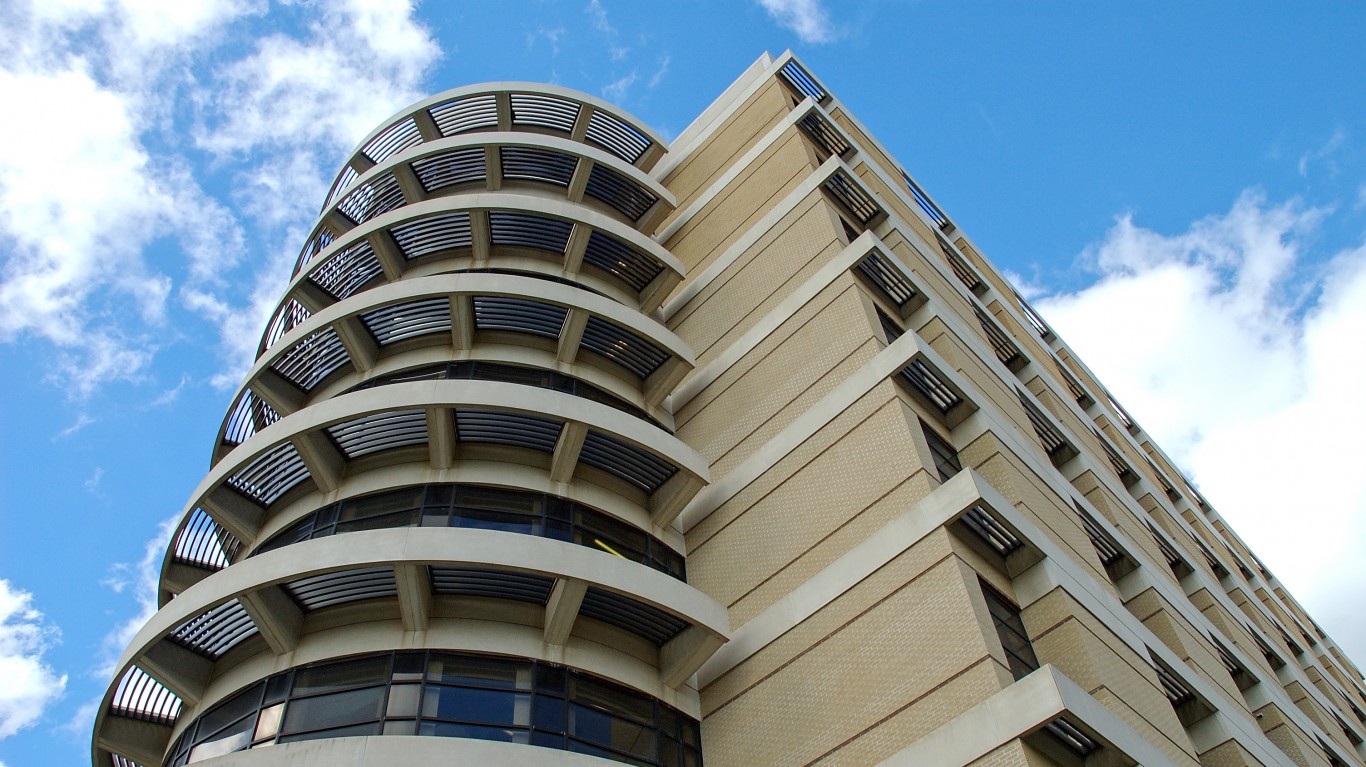
24. Mississippi
> Adults with unpaid med. bills: 933,512 (40.9% of adult pop. — the highest)
> Median medical debt in collections: $813 (10th highest)
> Uninsured rate: 12.1% (6th highest)
> Adults in fair or poor health: 22.2% (3rd highest)
A staggering 40.9% of the 2.3 million adults living in Mississippi have unpaid medical bills, the largest share of any state in the country. Having health insurance can significantly reduce what a patient pays out of pocket for medical care. In Mississippi, a state that has not adopted expanded Medicaid coverage, 12.1% of the population is uninsured, one of the larger shares among states.
Many in Mississippi face additional challenges in paying their bills, mainly low incomes. The majority of households in the state earn less than $45,000 a year. Meanwhile, most households nationwide earn over $61,000.
[in-text-ad-2]
25. Missouri
> Adults with unpaid med. bills: 1.3 million (26.9% of adult pop. — 12th highest)
> Median medical debt in collections: $781 (15th highest)
> Uninsured rate: 9.4% (17th highest)
> Adults in fair or poor health: 18.5% (14th highest)
Adults in Missouri are more likely than the typical American to have unpaid medical bills. As is the case in most states where similarly large shares of the population are saddled with health care debt, Missouri has a higher than average uninsured rate. An estimated 9.4% of the state population lacks health insurance, compared to 8.9% of the U.S. population. The state’s higher than average uninsured rate is partially because Missouri is one of a handful of states not to adopt Medicaid expansion.
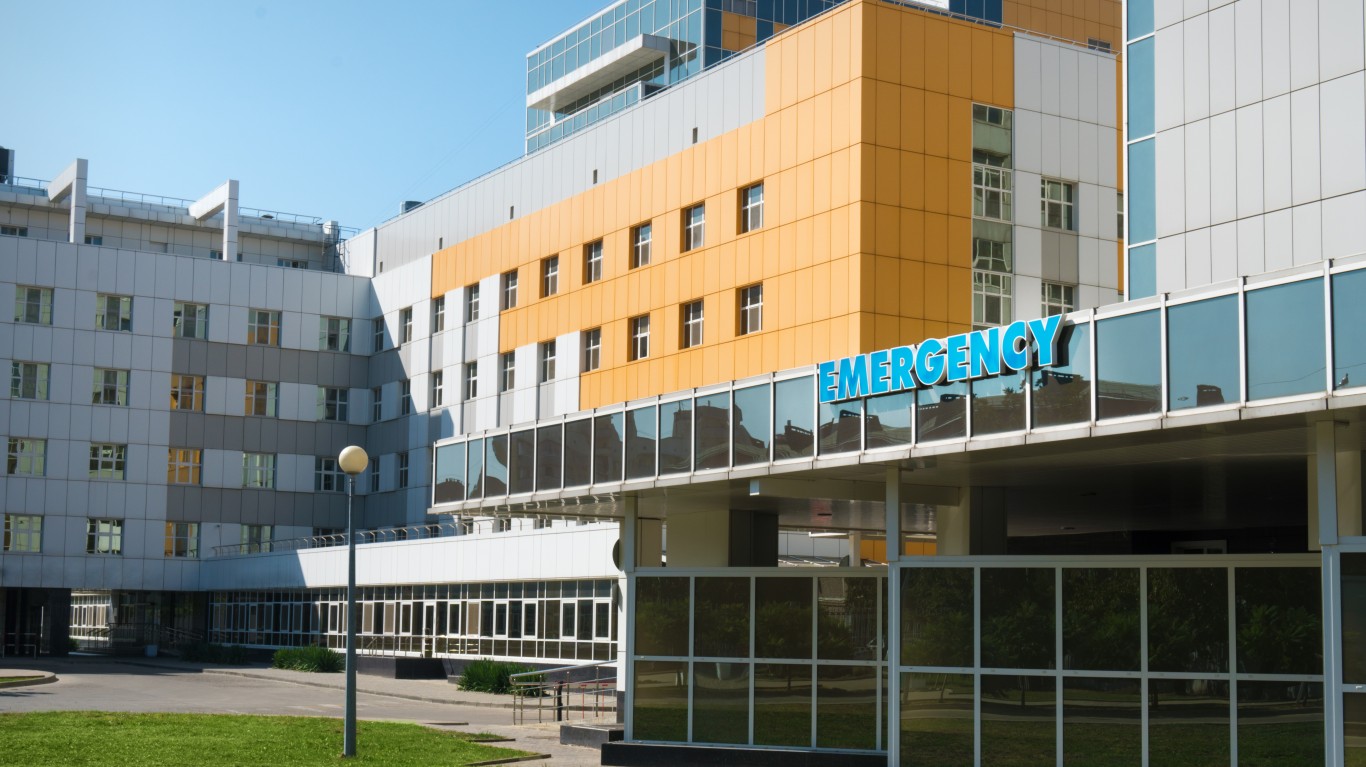
26. Montana
> Adults with unpaid med. bills: 217,396 (26.0% of adult pop. — 17th highest)
> Median medical debt in collections: $768 (17th highest)
> Uninsured rate: 8.2% (23rd highest)
> Adults in fair or poor health: 13.9% (12th lowest)
High medical costs appear to be taking a greater than average toll on public health in Montana. About 23.2% of adults in the state say they opted not to receive care for a medical problem because of costs, compared to 20.6% of adults nationwide. Indeed, Montana residents are more likely to have medical debt than Americans nationwide. An estimated 26.0% of state residents 18 and older have unpaid medical bills compared to 22.7% of adults nationwide.
[in-text-ad]

27. Nebraska
> Adults with unpaid med. bills: 312,235 (21.4% of adult pop. — 21st lowest)
> Median medical debt in collections: $481 (10th lowest)
> Uninsured rate: 8.3% (21st highest)
> Adults in fair or poor health: 14.2% (14th lowest)
The 21.4% share of adults with unpaid medical bills in Nebraska is slightly below the 22.7% share of adults nationwide with debt from medical treatment, consultation, or testing. Those with medical debt in Nebraska are also more likely to owe less than the typical American. The median amount of medical debt that has been turned over to collections agencies in the state is $481, well below the national median of $694.
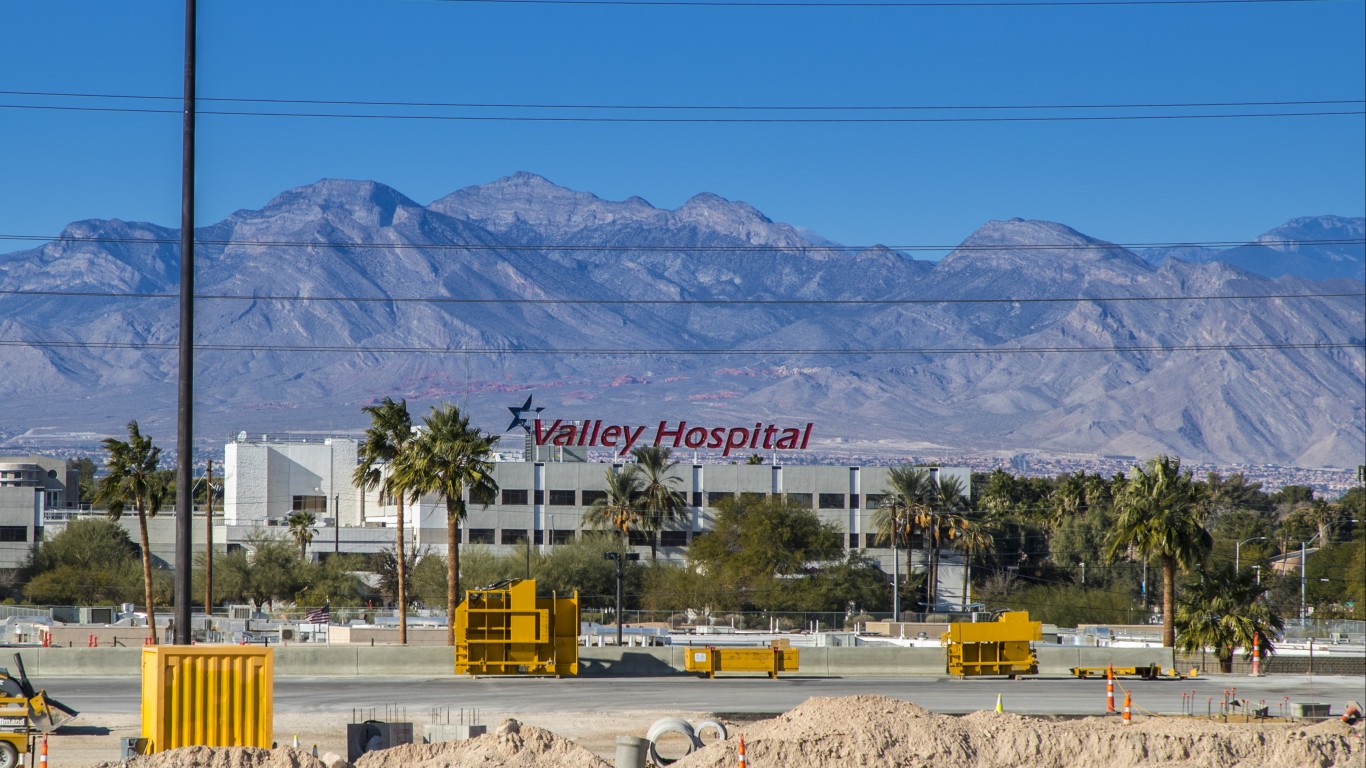
28. Nevada
> Adults with unpaid med. bills: 538,764 (23.0% of adult pop. — 24th lowest)
> Median medical debt in collections: $775 (16th highest)
> Uninsured rate: 11.2% (7th highest)
> Adults in fair or poor health: 20.5% (8th highest)
In Nevada, 23.0% of residents 18 and older have unpaid medical bills, in line with the 22.7% share of American adults with health care debt. Still, Nevada residents are more likely to skip treatment for a medical problem due to cost than the typical American.
The share of adults in Nevada with unpaid medical bills would likely considerably decline with greater insurance coverage. Currently, 11.2% of state residents are without health insurance, well above the national uninsured rate of 8.9%.
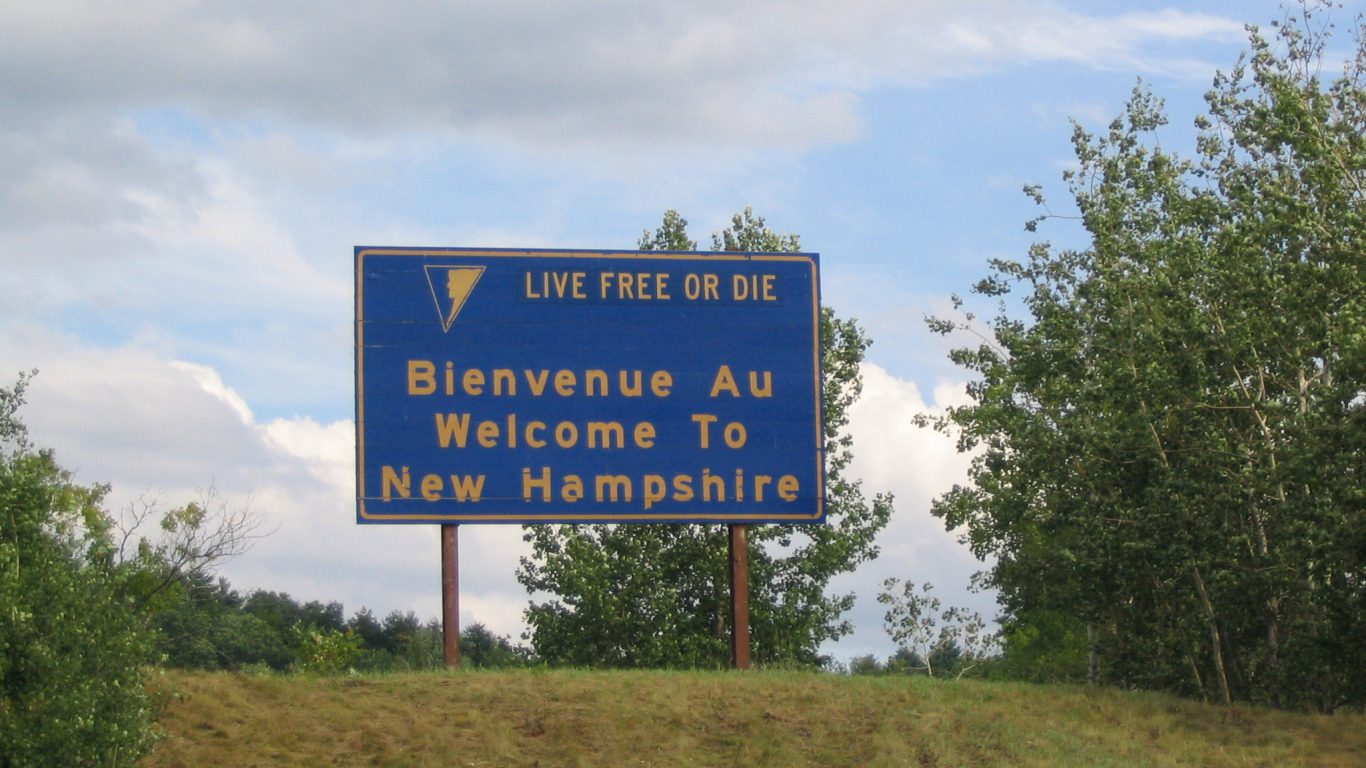
29. New Hampshire
> Adults with unpaid med. bills: 270,225 (24.6% of adult pop. — 21st highest)
> Median medical debt in collections: $458 (6th lowest)
> Uninsured rate: 5.7% (14th lowest)
> Adults in fair or poor health: 13.6% (7th lowest)
Over a quarter million adults in New Hampshire have unpaid bills from hospital visits, doctor’s appointments, or medical tests — or 24.6% of the 18 and older population. Nationwide, 22.7% of adults have unpaid medical bills.
While health insurance reduces the financial burden of health care, medical treatment can still come with high out-of-pocket costs for patients. In New Hampshire, 5.7% of the population is uninsured, a smaller share than the 8.9% of adults nationwide.
[in-text-ad-2]

30. New Jersey
> Adults with unpaid med. bills: 1.1 million (16.2% of adult pop. — 4th lowest)
> Median medical debt in collections: $510 (13th lowest)
> Uninsured rate: 7.4% (23rd lowest)
> Adults in fair or poor health: 16.5% (23rd highest)
The 16.2% share of adults with unpaid medical bills in New Jersey is well below the comparable share in most other states and the 22.7% share of adults nationwide. Higher-income areas tend to have smaller shares of residents with medical debt, and in New Jersey, the typical household earns $81,740 a year, about $20,000 more than the typical American household. New Jersey residents are also more likely than most Americans to have health insurance coverage.
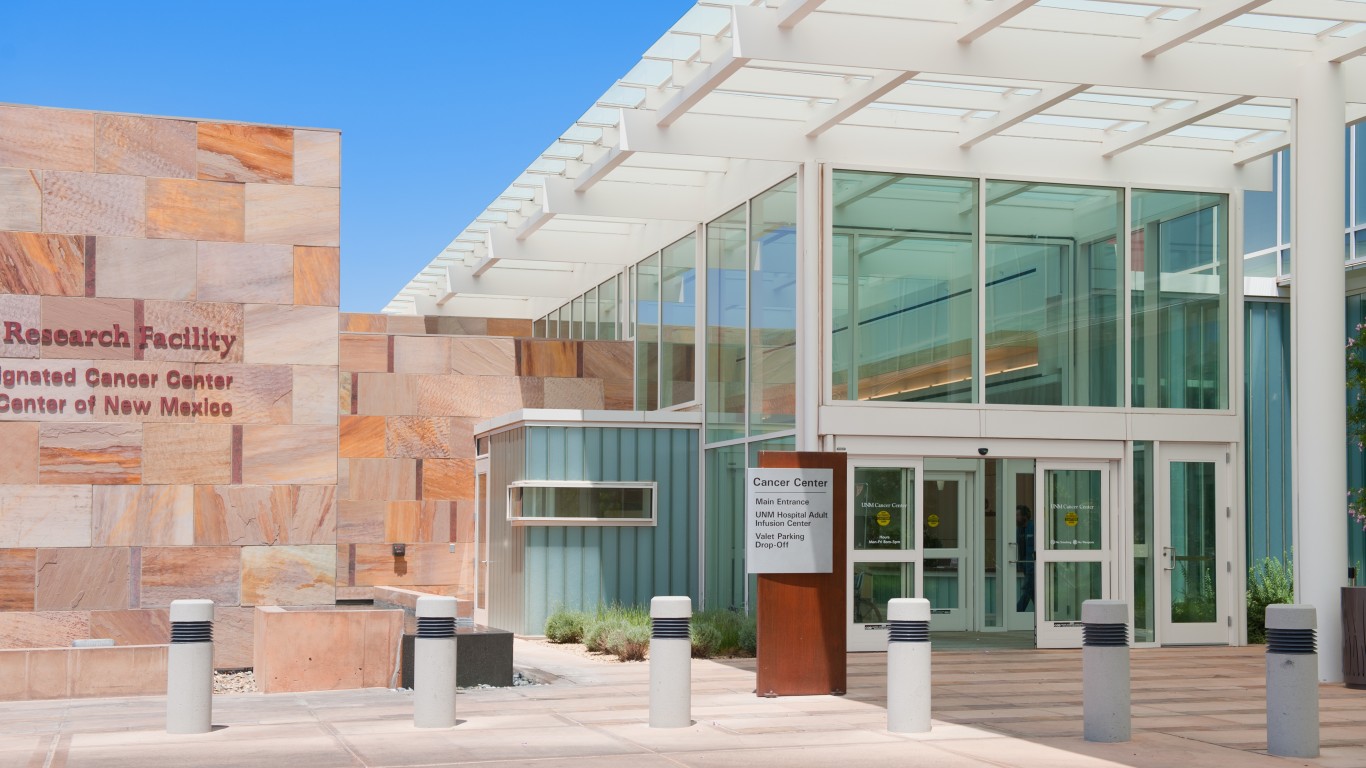
31. New Mexico
> Adults with unpaid med. bills: 243,748 (15.1% of adult pop. — 3rd lowest)
> Median medical debt in collections: $731 (22nd highest)
> Uninsured rate: 9.5% (16th highest)
> Adults in fair or poor health: 20.8% (7th highest)
Most states with relatively low incomes and high uninsured rates are also home to relatively larger shares of adults with unpaid medical bills. But New Mexico is an exception. The median annual household income in the state is $47,169, and 9.5% of state residents are uninsured. Meanwhile, the median household income nationwide is $61,937, and 8.9% of the U.S. population does not have health insurance. Still, just 15.1% of adults in New Mexico have unpaid medical bills, well below the 22.7% share of adults nationwide.
[in-text-ad]
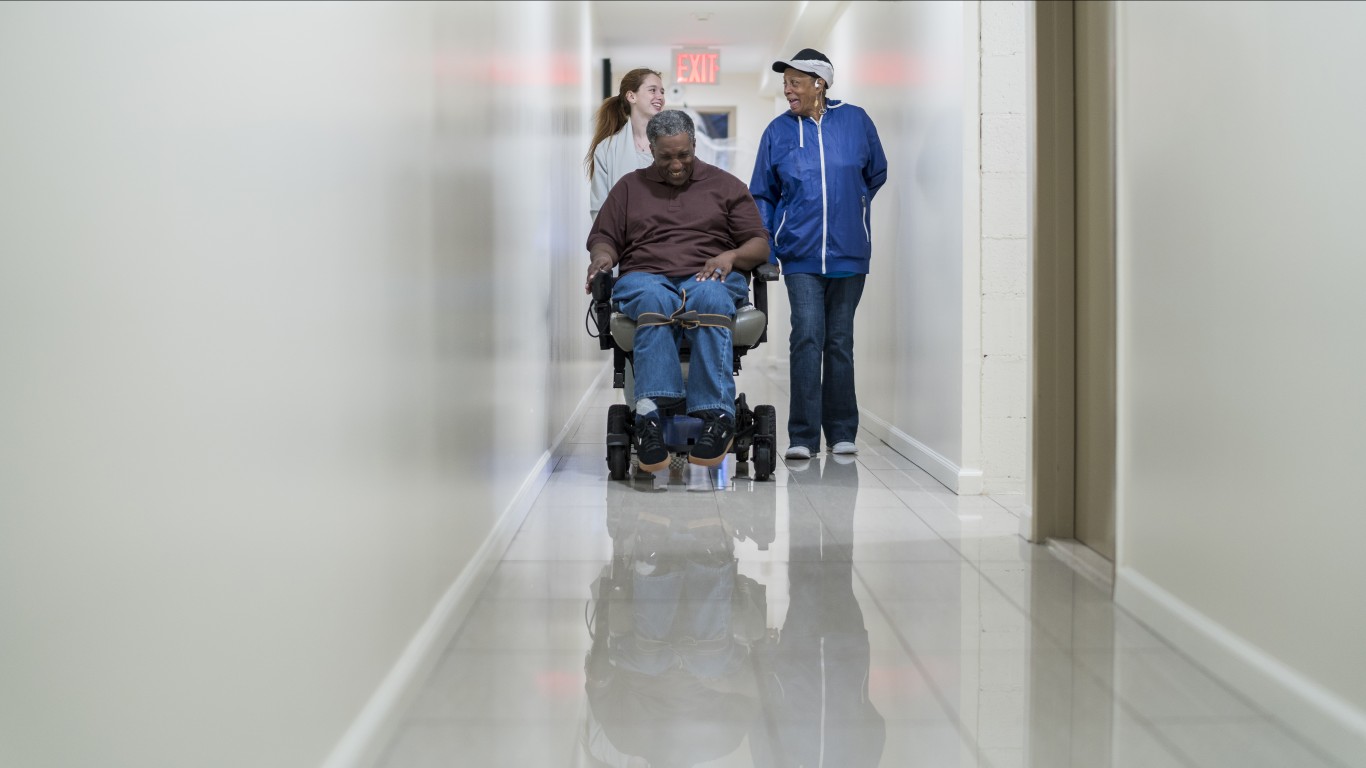
32. New York
> Adults with unpaid med. bills: 2.7 million (17.7% of adult pop. — 10th lowest)
> Median medical debt in collections: $446 (5th lowest)
> Uninsured rate: 5.4% (9th lowest)
> Adults in fair or poor health: 16.1% (24th highest)
There are 2.7 million adults in New York state with unpaid medical bills, or 17.7% of the 18 and older population — a smaller share than in most states. As is often the case where relatively small shares of adults have medical debt,
New York has high incomes and relatively more residents with health insurance coverage. The median annual household income in the state is $67,844 a year, and 5.4% of state residents are uninsured. Meanwhile, the median household income nationwide is $61,937, and 8.9% of the U.S. population does not have health insurance.
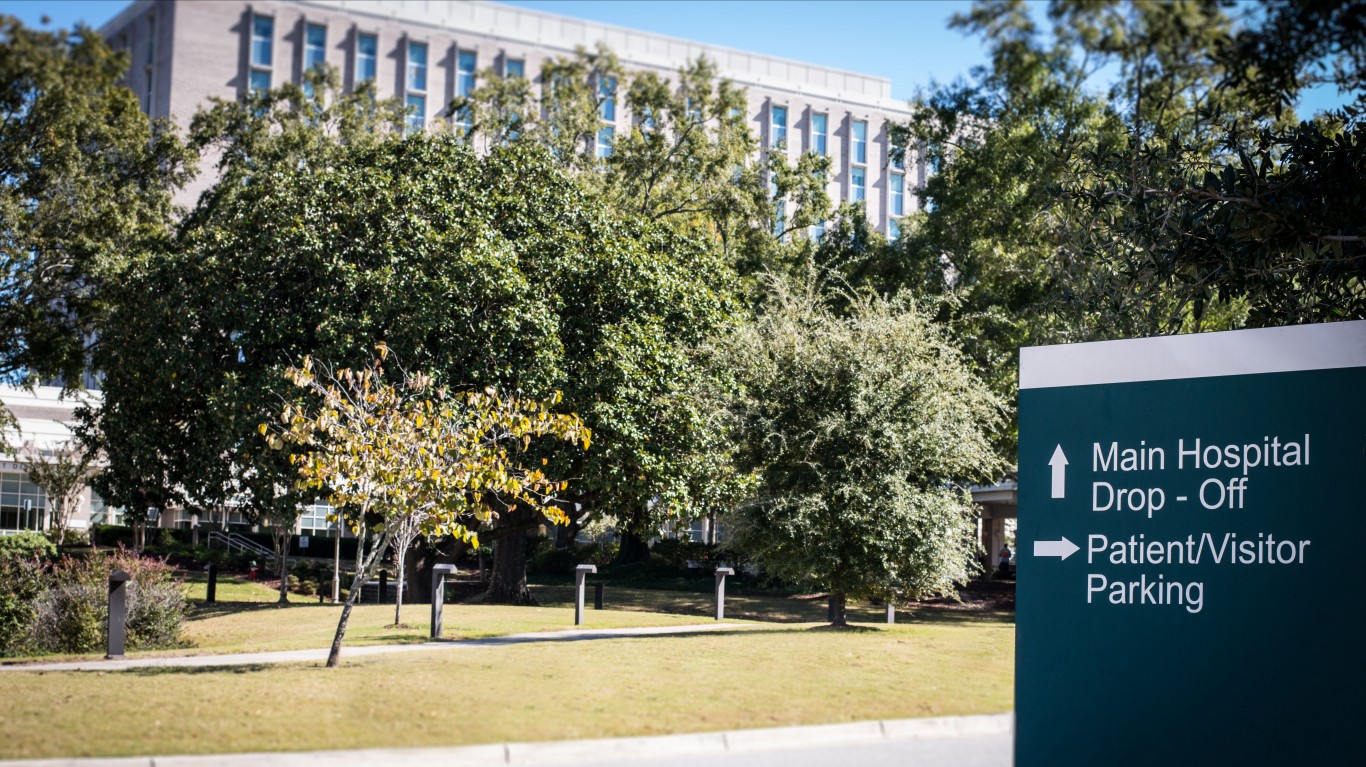
33. North Carolina
> Adults with unpaid med. bills: 2.2 million (27.0% of adult pop. — 11th highest)
> Median medical debt in collections: $698 (24th highest)
> Uninsured rate: 10.7% (9th highest)
> Adults in fair or poor health: 17.6% (18th highest)
North Carolina is one of only 14 states not to have adopted Medicaid expansion. Partially as a result, North Carolina’s 10.7% uninsured rate is one of the 10 highest among all states. Health insurance takes a considerable financial burden off the patient, and North Carolina’s high uninsured rate likely helps explain why a higher than average share of adults have unpaid medical bills, at 27.0%.
While North Carolinians are more likely than most Americans to have medical debt, those with debt do not typically have more of it. The median amount of medical debt that has been turned over to collections agencies in the state is $698, in line with the comparable national median.
34. North Dakota
> Adults with unpaid med. bills: 119,234 (20.3% of adult pop. — 18th lowest)
> Median medical debt in collections: $624 (22nd lowest)
> Uninsured rate: 7.3% (22nd lowest)
> Adults in fair or poor health: 14.3% (15th lowest)
In North Dakota, 20.3% of residents 18 and older have unpaid medical bills, a smaller share than in most states. Still, North Dakota residents are less likely to seek treatment for a medical problem due to medical costs than the typical American.
The lower likelihood of medical debt among adults in North Dakota may be attributable to less frequent treatment, as state residents are more likely to have better assessments of their own health than Americans on average. For example, just 14.3% of adults in the state report being in fair or poor health, compared to 16.0% of American adults nationwide.
[in-text-ad-2]

35. Ohio
> Adults with unpaid med. bills: 2.2 million (24.4% of adult pop. — 23rd highest)
> Median medical debt in collections: $531 (15th lowest)
> Uninsured rate: 6.5% (18th lowest)
> Adults in fair or poor health: 17.0% (22nd highest)
Ohio residents age 18 and up are slightly more likely than the typical American adult to be saddled with unpaid medical bills. Although Ohio residents are more likely to have health insurance coverage, even with insurance, health care can come with considerable out-of-pocket costs — and people in Ohio are more likely to have limited financial resources. The typical household in the state earns $56,111 a year, nearly $6,000 less than the typical American household.

36. Oklahoma
> Adults with unpaid med. bills: 798,111 (26.7% of adult pop. — 14th highest)
> Median medical debt in collections: $857 (7th highest)
> Uninsured rate: 14.2% (2nd highest)
> Adults in fair or poor health: 19.6% (9th highest)
Oklahoma is one of only 14 states not to have adopted Medicaid expansion through the Affordable Care Act, and partially as a result, state residents are less likely to have health insurance. Oklahoma’s uninsured rate of 14.2% is the second highest of any state and well above the comparable nationwide rate of 8.9%. Americans seeking medical treatment without health insurance have considerably higher out-of-pocket expenses, and in Oklahoma, 26.7% of adults have unpaid medical bills, well above the 22.7% of American adults nationwide who do.
[in-text-ad]

37. Oregon
> Adults with unpaid med. bills: 672,365 (20.3% of adult pop. — 17th lowest)
> Median medical debt in collections: $647 (23rd lowest)
> Uninsured rate: 7.1% (20th lowest)
> Adults in fair or poor health: 15.8% (24th lowest)
Oregon residents are more likely to have health insurance coverage and higher incomes than the Americans nationwide. Partially as a result, just 20.3% of adults in the state have outstanding medical bills, a smaller share than in most other states.
Still, even with health insurance, trips to the doctor, emergency room, or a clinic can come with high out-of-pocket costs. In the last year, 21.1% of adults in Oregon have had a medical problem yet not sought treatment due to the cost, slightly higher than the 20.6% of adults nationwide.
38. Pennsylvania
> Adults with unpaid med. bills: 2.1 million (21.1% of adult pop. — 20th lowest)
> Median medical debt in collections: $512 (14th lowest)
> Uninsured rate: 5.5% (11th lowest)
> Adults in fair or poor health: 15.1% (19th lowest)
Likely due in part to a lower than average uninsured rate, adults in Pennsylvania are less likely than most American adults to be saddled with medical debt. An estimated 21.1% of Pennsylvania residents 18 and older have unpaid health care bills — a slightly smaller share than the 22.7% of adults nationwide.
Pennsylvania residents are also less likely than most Americans to be deterred from seeking necessary medical treatment because of concerns over cost. Just 16.8% of adults in the state have opted to not get treatment in the last 12 months for a known medical problem because of cost, below the comparable share of adults nationwide of 20.6%.
39. Rhode Island
> Adults with unpaid med. bills: 146,634 (17.2% of adult pop. — 7th lowest)
> Median medical debt in collections: $468 (8th lowest)
> Uninsured rate: 4.1% (4th lowest)
> Adults in fair or poor health: 14.8% (17th lowest)
Like many other states in the Northeast, all of which have adopted Medicaid expansion under the Affordable Care Act, Rhode Island has a low uninsured rate. Just 4.1% of state residents are without health insurance, less than half the 8.9% national uninsured rate. Partially as a result, adults in the state are far less likely than Americans nationwide to be saddled with unpaid medical bills. Additionally, Rhode Island residents are less likely than the average American to be deterred from seeking necessary medical treatment due to concerns related to cost.
[in-text-ad-2]
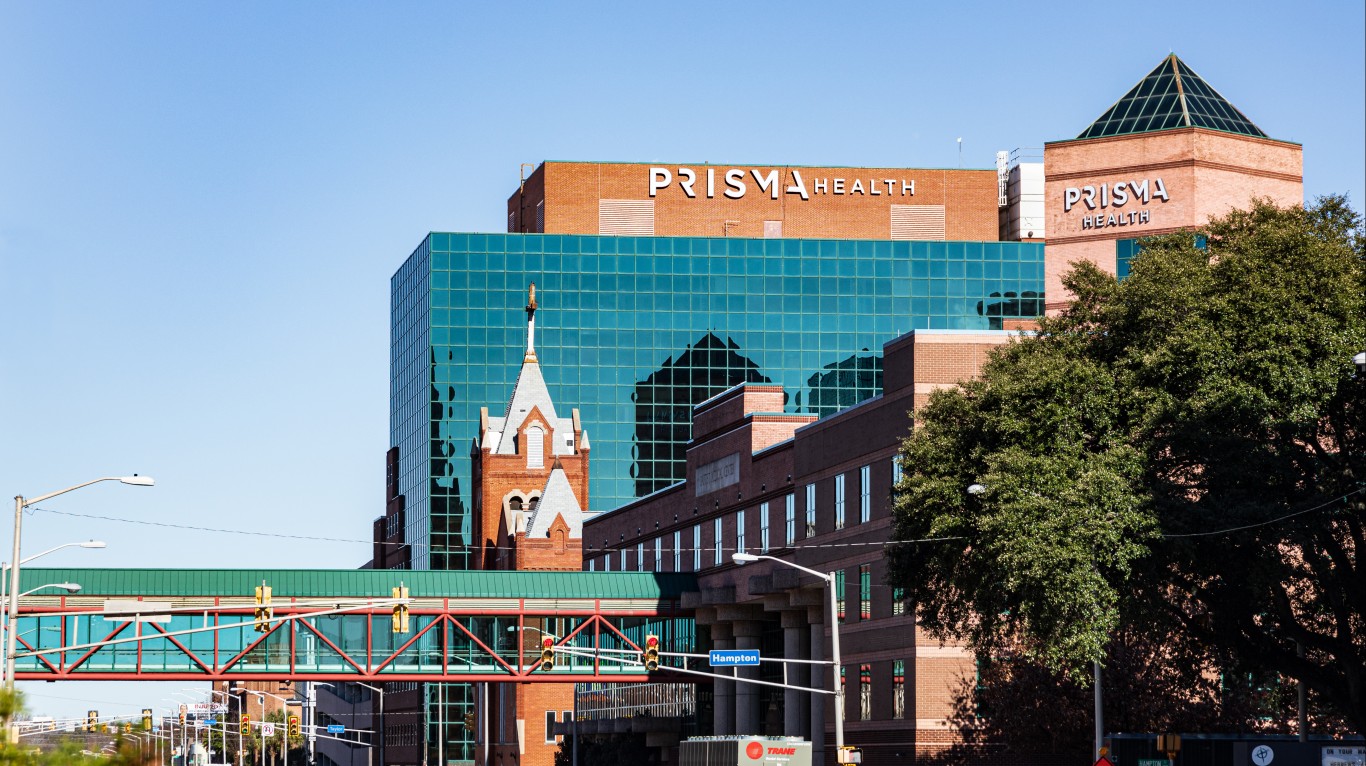
40. South Carolina
> Adults with unpaid med. bills: 1.3 million (31.4% of adult pop. — 2nd highest)
> Median medical debt in collections: $787 (14th highest)
> Uninsured rate: 10.5% (11th highest)
> Adults in fair or poor health: 19.1% (11th highest)
A staggering 31.4% of adults in South Carolina have unpaid medical bills, the second largest share of any state. The prevalence of medical debt is likely due in large part to the high uninsured rate in the state, which is exacerbated by low incomes. The median annual household income in the state is $52,306, and 10.5% of state residents are uninsured. Meanwhile, the median household income nationwide is $61,937, and 8.9% of the U.S. population does not have health insurance.
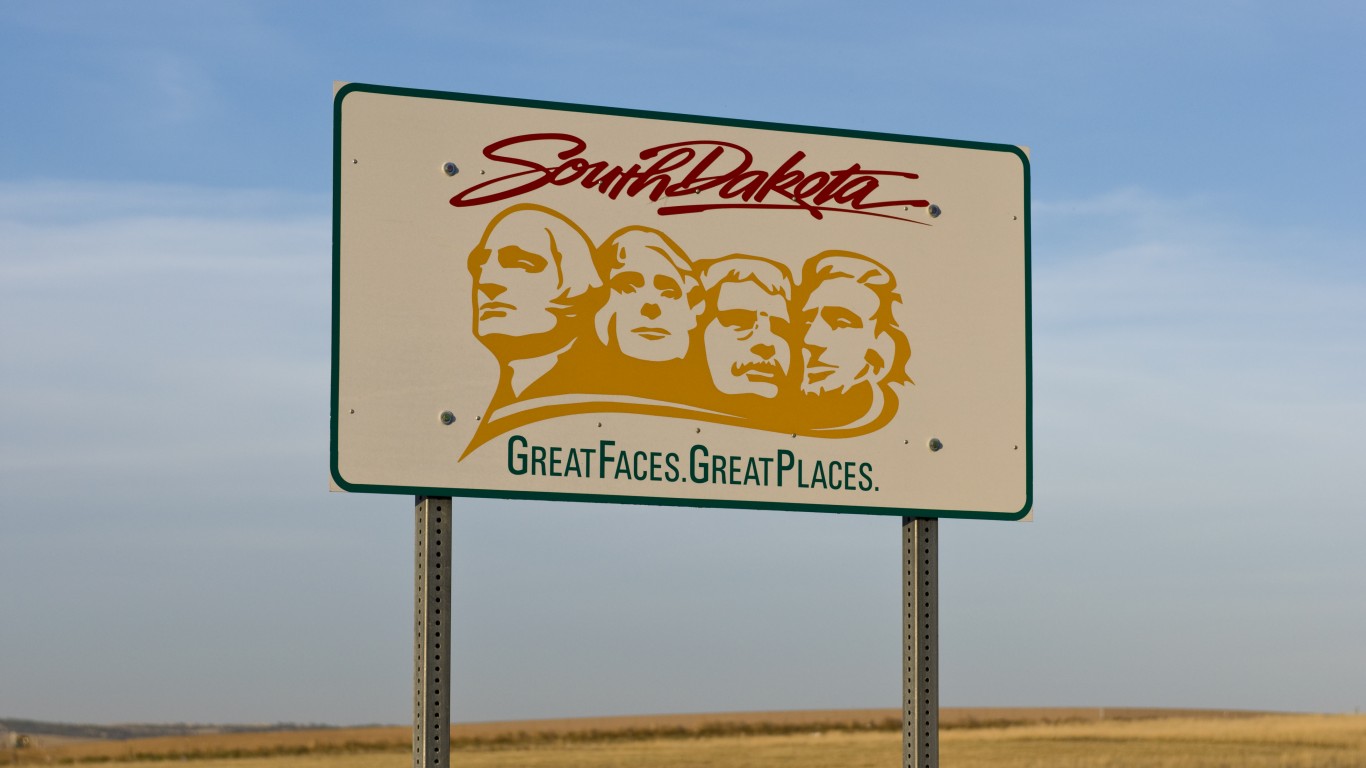
41. South Dakota
> Adults with unpaid med. bills: 164,003 (24.5% of adult pop. — 22nd highest)
> Median medical debt in collections: $542 (17th lowest)
> Uninsured rate: 9.8% (15th highest)
> Adults in fair or poor health: 11.8% (the lowest)
In South Dakota, 25.7% of adults have not sought necessary medical treatment in the last year because of concerns related to cost — well above the 20.6% of American adults. Indeed, the percentage of South Dakota residents with unpaid medical bills is higher than average.
Concerns over medical costs in South Dakota are likely exacerbated for the state’s relatively large uninsured population. South Dakota is one of 14 states not to have adopted Medicaid expansion under the Affordable Care Act, and currently, 9.8% of residents are uninsured, compared to 8.9% of Americans nationwide.
[in-text-ad]

42. Tennessee
> Adults with unpaid med. bills: 1.3 million (25.6% of adult pop. — 19th highest)
> Median medical debt in collections: $855 (8th highest)
> Uninsured rate: 10.1% (13th highest)
> Adults in fair or poor health: 19.1% (10th highest)
In Tennessee, 25.6% of the 18 and older population has unpaid medical bills, slightly more than the 22.7% national share. That figure would likely be reduced by greater health insurance coverage. As one of the 14 states not to adopt Medicaid expansion, Tennessee currently has a 10.1% uninsured rate, which is higher than the uninsured rate in the vast majority of states.
Over the last 12 months, the high cost of medical care has discouraged 21.8% of adults in Tennessee from seeking treatment for a health problem — higher the comparable national figure of 20.6%.

43. Texas
> Adults with unpaid med. bills: 6.2 million (29.0% of adult pop. — 5th highest)
> Median medical debt in collections: $829 (9th highest)
> Uninsured rate: 17.7% (the highest)
> Adults in fair or poor health: 18.2% (15th highest)
In Texas, 17.7% of the population does not have health insurance, the highest uninsured rate of any state. Partially as a result, a staggering 6.2 million adults in the state have unpaid medical bills — or 29.0% of Texas residents age 18 and up. Nationwide, 22.7% of adults are saddled with medical debt.
The state’s high uninsured rate is a threat to overall public health. Over the last year, the high cost of medical care has discouraged 26.1% of adults in Texas from seeking treatment for a health problem — well above the comparable 20.6% national figure.

44. Utah
> Adults with unpaid med. bills: 448,181 (20.1% of adult pop. — 15th lowest)
> Median medical debt in collections: $997 (4th highest)
> Uninsured rate: 9.4% (17th highest)
> Adults in fair or poor health: 12.1% (3rd lowest)
The share of adults in Utah with unpaid medical bills, at 20.1%, is slightly below the comparable share nationwide of 22.7%. However, those unpaid bills are likely higher than average for many in the state. The median unpaid hospital, clinic, or doctor bill that has been turned over to a collections agency in Utah is $997, about $300 more than the national average.
Having health insurance coverage can greatly reduce out-of-pocket medical expenses, and in Utah, 9.4% of the population is uninsured, slightly higher than the 8.9% national rate.
[in-text-ad-2]
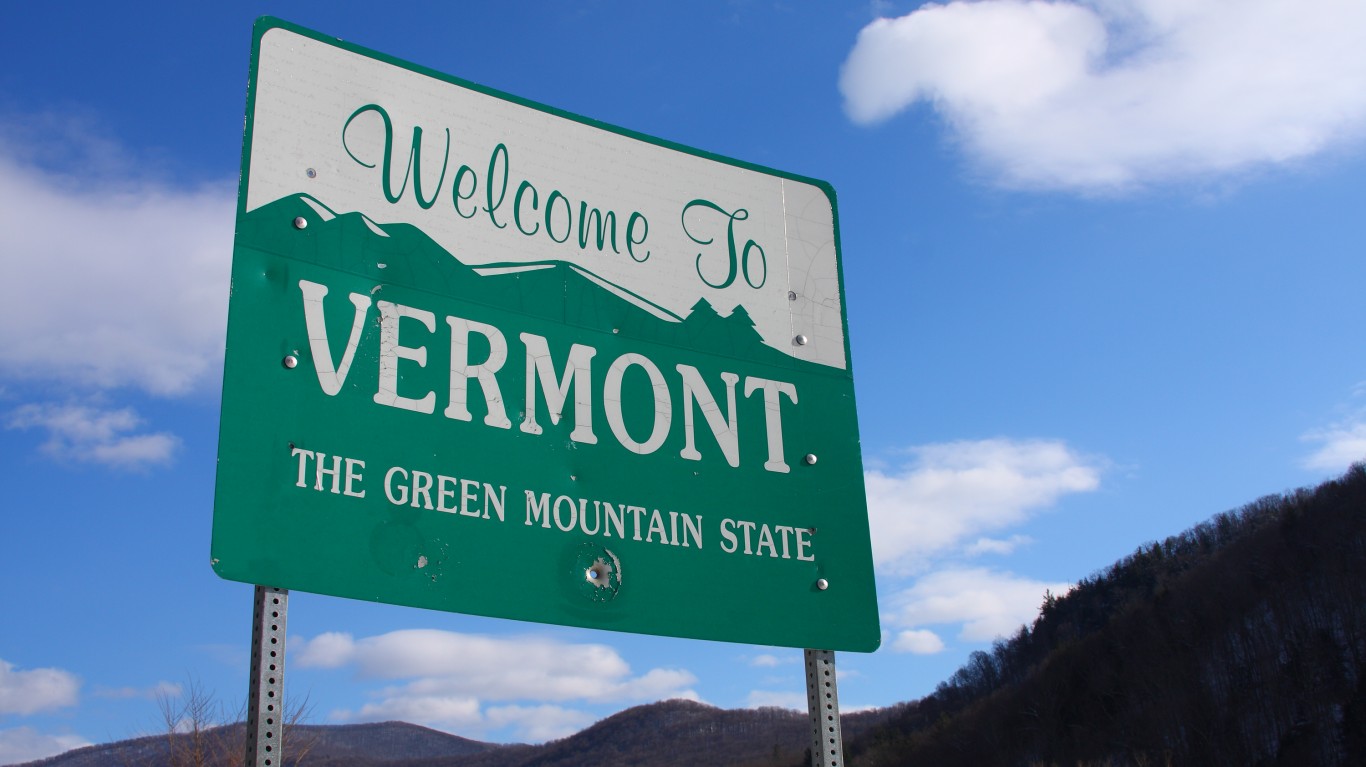
45. Vermont
> Adults with unpaid med. bills: 119,842 (23.4% of adult pop. — 25th highest)
> Median medical debt in collections: $469 (9th lowest)
> Uninsured rate: 4.0% (2nd lowest)
> Adults in fair or poor health: 12.5% (4th lowest)
As is the case across much of New England and the broader Northeastern United States, Vermont has an exceptionally low uninsured rate. Just 4.0% of Vermonters do not have health insurance, less than half the 8.9% national uninsured rate.
However, even with insurance, health care can have high out-of-pocket costs that many Americans struggle to afford. Despite the high insurance coverage in Vermont, 23.4% of adults in the state have unpaid medical bills, higher than the 22.7% national share.
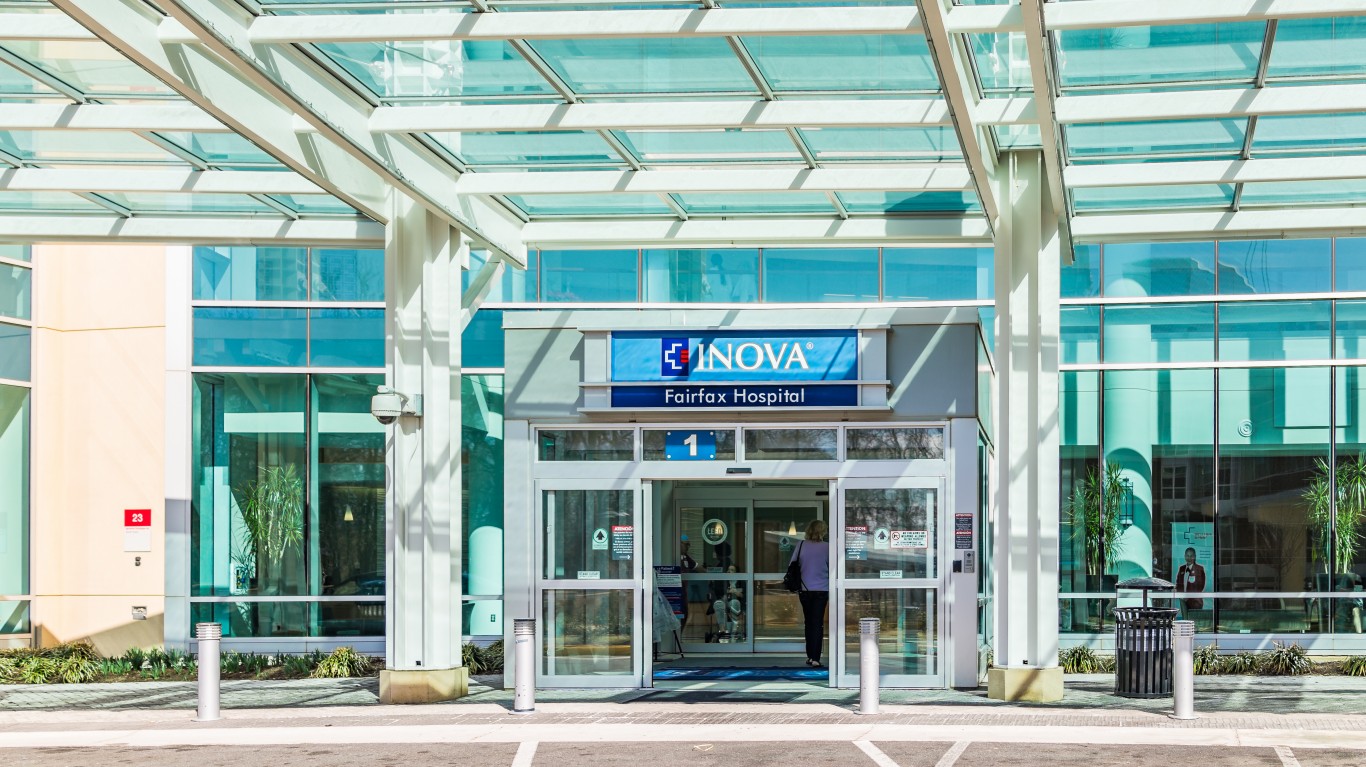
46. Virginia
> Adults with unpaid med. bills: 1.5 million (23.1% of adult pop. — 25th lowest)
> Median medical debt in collections: $680 (25th lowest)
> Uninsured rate: 8.8% (19th highest)
> Adults in fair or poor health: 15.9% (25th highest)
There are 1.5 million Virginia residents 18 and older with unpaid medical bills, or 23.1% of the adult population — a larger share than the 22.7% of American adults saddled with medical debt. Virginians are also more likely to be discouraged from seeking treatment for a medical problem than most Americans.
Overall, people in Virginia appear more likely to lead healthy lifestyles than most Americans. State residents are less likely to smoke and more likely to exercise regularly than average.
[in-text-ad]
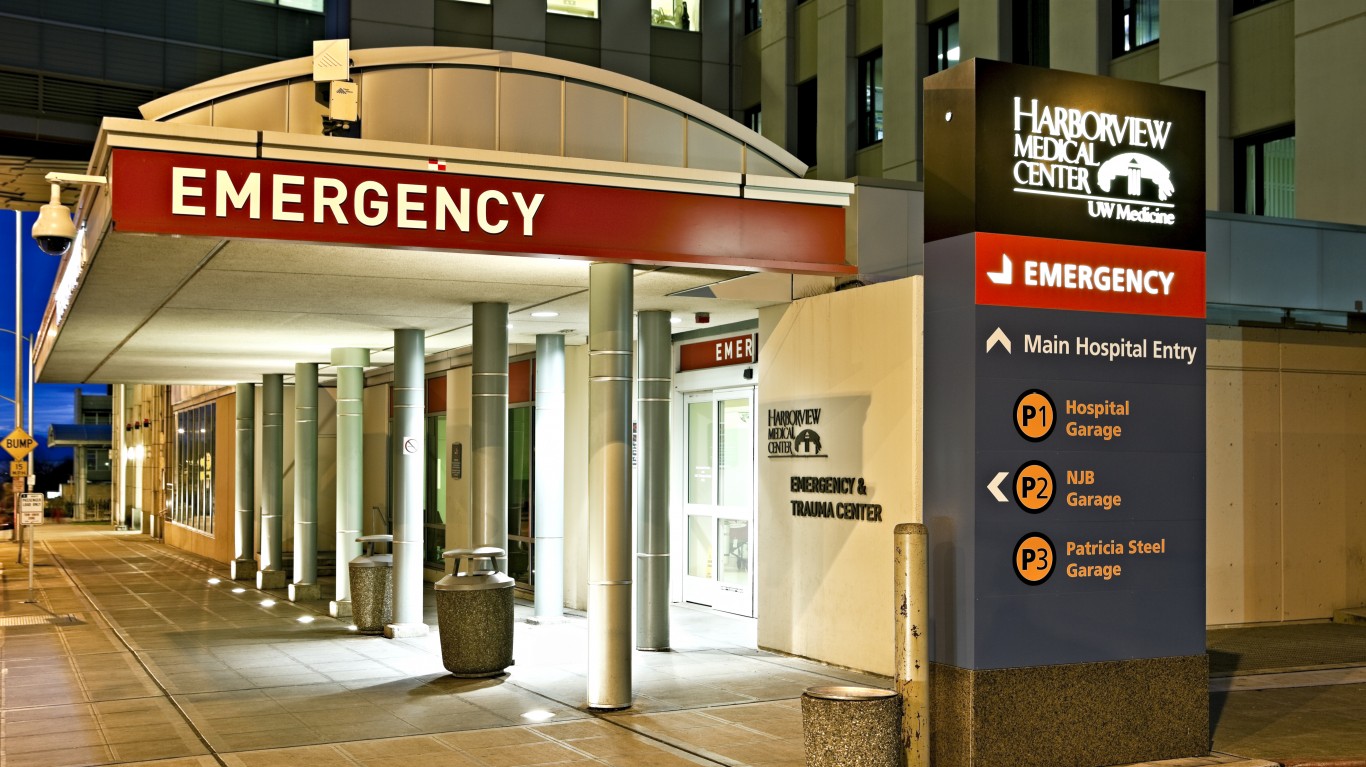
47. Washington
> Adults with unpaid med. bills: 1.0 million (17.7% of adult pop. — 9th lowest)
> Median medical debt in collections: $559 (19th lowest)
> Uninsured rate: 6.4% (17th lowest)
> Adults in fair or poor health: 13.9% (10th lowest)
Health insurance coverage significantly reduces out-of-pocket medical expenses. In Washington state, only 6.4% of the population is uninsured, well below the 8.9% national uninsured rate. Washington residents are also far more likely than Americans nationwide to have the financial resources to pay their medical bills. The typical household in the state earns $74,073 per year, about $12,000 more than the typical American household.
Due in large part to these factors, adults in Washington are also far less likely than Americans 18 and older to be saddled with medical debt. Just 17.7% of adults in the state have unpaid medical bills, compared to 22.7% of adults nationwide.

48. West Virginia
> Adults with unpaid med. bills: 450,493 (31.2% of adult pop. — 3rd highest)
> Median medical debt in collections: $680 (25th lowest)
> Uninsured rate: 6.4% (17th lowest)
> Adults in fair or poor health: 24.1% (2nd highest)
West Virginia is one of only three states where over 30% of the 18 and older population have unpaid medical bills. Even though West Virginians are more likely than Americans in most states to have health insurance coverage, out-of-pocket medical expenses can be high even for those with insurance coverage — and in West Virginia, many lack the financial resources to cover those costs. The typical household in West Virginia earns just $44,097 a year, the lowest median income of any state and nearly $18,000 less than the median nationwide.

49. Wisconsin
> Adults with unpaid med. bills: 1.0 million (22.6% of adult pop. — 23rd lowest)
> Median medical debt in collections: $1,015 (3rd highest)
> Uninsured rate: 5.5% (11th lowest)
> Adults in fair or poor health: 15.4% (22nd lowest)
The share of adults in Wisconsin with unpaid medical bills, at 22.6%, is almost exactly in line with the national figure of 22.7%. However, those with medical debt in the state are more likely to have more of it compared to the average nationwide. The median amount of debt that has been turned over to collections agencies in Wisconsin is $1,015, more than in all but two other states and well above the national median of $694.
Older Americans typically need more frequent, and often more expensive medical treatment. In Wisconsin, 17% of the population is 65 or older compared to 16% of the total U.S. population.
[in-text-ad-2]

50. Wyoming
> Adults with unpaid med. bills: 110,250 (24.7% of adult pop. — 20th highest)
> Median medical debt in collections: $1,252 (2nd highest)
> Uninsured rate: 10.5% (11th highest)
> Adults in fair or poor health: 15.1% (20th lowest)
In Wyoming, 26.8% of adults have not sought treatment for a medical problem because of concerns related to cost, well above the comparable national share of 20.6%. Indeed, the share of adults who are saddled with medical debt in the state is higher than the national average.
Out-of-pocket medical costs are higher for Americans without insurance, and in Wyoming, 10.5% of the population is uninsured.
Methodology
To determine how many people are burdened with medical debt in each state, 24/7 Wall St. reviewed survey data from the Financial Industry Regulatory Authority, or FINRA, a non-government agency. The 2018 survey asked between 500 and 1,250 adults (18 and over) in each state whether they had any unpaid bills from a health care or medical service provider — such as a hospital, doctor’s office, or testing lab — that are past due.
The share of adults who had a medical problem but did not go to a doctor or clinic because of the cost in the last 12 months is also from the FINRA survey.
In our analysis, we also reviewed the median amount of medical debt that has been turned over to collections agencies. This figure is for 2018 and came from the Urban Institute, a social and economic policy think tank.
Measures of health outcomes and behaviors, including smoking, exercise, and obesity rates, as well as the share of adults who report being in fair or poor health, came from County Health Rankings & Roadmaps, a Robert Wood Johnson Foundation and University of Wisconsin Population Health Institute joint program and are for the most recent year available.
Data on uninsured rates and median household income came from the U.S. Census Bureau’s 2018 American Community Survey.
Retirement can be daunting, but it doesn’t need to be.
Imagine having an expert in your corner to help you with your financial goals. Someone to help you determine if you’re ahead, behind, or right on track. With SmartAsset, that’s not just a dream—it’s reality. This free tool connects you with pre-screened financial advisors who work in your best interests. It’s quick, it’s easy, so take the leap today and start planning smarter!
Don’t waste another minute; get started right here and help your retirement dreams become a retirement reality.
Thank you for reading! Have some feedback for us?
Contact the 24/7 Wall St. editorial team.